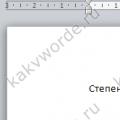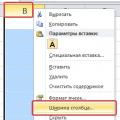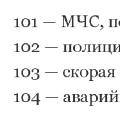When recording some files to an external HDD(flash drive, memory card) an error suddenly appears. But everything is correct, the disk opens in Explorer, other files are copied and deleted, but one file is not written even if you crack it! Even formatting doesn't help.
Look at the file size, I'm sure it will be more than 4GB. And if such a file is not copied to external storage, which means it needs to be formatted again, but to the NTFS file system.
Formatting to NTFS
Right-click on the disk and select “Format…”
IMPORTANT: The file system should be NTFS, that's the whole point. Leave the “Quick (cleaning table of contents)” checkbox. "Volume label" - any. Click “Start” and wait for the process to complete.
WHEN FORMATING ALL DATA ON THIS DISK WILL BE DESTROYED! So if there are any, copy them to another location first.
Now you can record any files. The whole point was that your USB drive was formatted in the FAT32 system, where the maximum size of one file is only 4GB. Please note that not all external devices understand the NTFS format.
The situation when you urgently need to copy something to a flash drive, but as luck would have it, the computer freezes or gives an error, is probably familiar to many users. They spend a lot of time in vain searches for a solution to the problem, but they leave it unresolved, attributing everything to a drive malfunction or a problem with the computer. But in most cases this is not the case at all.
There may be several reasons why a file cannot be copied to a flash drive. Accordingly, there are several ways to solve this problem. Let's look at them in more detail.
Reason 1: Lack of free space on the flash drive
For people who are familiar with the principles of storing information on a computer at a level at least slightly higher than the initial level, this situation may seem too basic or even ridiculous to be covered in an article. But nevertheless, there are a huge number of users who are just starting to learn the basics of working with files, so even such a simple problem can confuse them. The information below is intended for them.
If you try to copy files to a flash drive that does not have enough free space, the system will display the following message: 
This message indicates the cause of the error as informatively as possible, so the user can only free up space on the flash drive so that the information he needs fits on it in full.
There is also a situation when the size of the drive is smaller than the amount of information that is planned to be copied to it. You can check this by opening Explorer in Datasheet view. The sizes of all partitions will be indicated there, indicating their total volume and remaining free space. 
If the size of the removable media is insufficient, you should use another flash drive.
Reason 2: File size does not match file system capabilities
Not everyone has knowledge about file systems and their differences. Therefore, many users are perplexed: the flash drive has the necessary free space, but when copying, the system gives an error: 
This error occurs only in cases when an attempt is made to copy a file whose size exceeds 4 GB to a flash drive. This is explained by the fact that the drive is formatted in the FAT32 file system. This file system was used in older versions of Windows, and flash drives are formatted in it for greater compatibility with various devices. However maximum size The file it can store is 4 GB.
You can check which file system is used on your flash drive from Explorer. It's very easy to do this:

To solve the problem, the flash drive must be formatted in the NTFS file system. This is done like this:

Once the flash drive is formatted, you can safely copy large files to it.
Reason 3: Problems with the integrity of the file system of the flash drive
Often the reason that a file refuses to be copied to removable media is accumulated errors in its file system. The reason for their occurrence is most often premature removal of the drive from the computer, power outages, or simply prolonged use without formatting.
Decide this problem possible by system means. To do this you need:

If the reason for the copying failure was errors file system, then after checking the problem will go away.
In cases where the flash drive does not contain any information valuable to the user, you can simply format it.
Reason 4: The media is write-protected
This problem often occurs among owners of laptops or standard PCs that have card readers for reading from SD or MicroSD drives. Flash drives of this type, as well as some models of USB drives, have the ability to physically block writing to them using a special switch on the case. The ability to write to removable media can also be blocked in Windows settings, regardless of whether there is physical protection or not. In any case, when trying to copy files to a flash drive, the user will see the following message from the system: 
To solve this problem, you need to move the switch lever on the flash drive body or change Windows settings. This can be done using system tools or using special programs.
If the methods described above for solving problems did not help and it is still impossible to copy files to a flash drive, the problem may be a malfunction of the media itself. In this case, it would be most advisable to contact service center, where specialists using special programs can restore the media.
Some users are still faced with the problem of handling files larger than 4 GB.
As a rule, this happens more and more often when downloading files from or somewhere else (because we rarely move files of this size, which means people simply don’t know that they have a similar problem and why they have it).
Error when file is larger than 4 GB
In the case of a torrent, the error looks like this: "One or more files exceed the file system size limit and cannot be downloaded."
In other cases, if my memory serves me correctly (and it happens :)), it sounds like “No access. The disk is full or write-protected.”
The essence of the problem is that the FAT32 file system (and users who encounter a similar problem use this particular file system) supports a maximum file size of 4,294,967,296 bytes and no more. Nothing can be done about it - that’s how it was intended from the very beginning.
The solution to the problem is to reformat or convert to the NTFS file system.
Solution 1
I’ll start with the second method as the most acceptable:
To start the conversion, do the following.
Start - Run - cmd
A console will open in front of you. Enter there:
convert D: /fs:ntfs
Where D: is the drive letter that you want to convert to NTFS format.
I don’t remember exactly, but I have an opinion that, as in the case of formatting, convert system disk, i.e. the one where the system is currently located will not work. The way out of this is either formatting or connecting hard disk to another computer.
Solution option 2
As for formatting...
It is impossible to do this without losing data, because formatting erases all files from the hard disk, and therefore you need to either be prepared for this and transfer all the information to external media, or simply buy new disk and format it with the NTFS file system. To format, click:
My computer - Right click on the desired disk - Format - File system: NTFS- we put "Quick Format" checkbox- Begin .
We are waiting for the formatting to finish.
Alternatively, you can cut the files into pieces to move them special programs, but this will not solve the problem in the case of downloading files from the Internet, and is it even worth making a fuss? In addition, changing the file system to NTFS will also have a positive effect on hard performance disk in and Windows Vista because both operating systems are made to work with this file system.
Afterword
That's how things are. If you have questions, ask in the comments.
Attention for old users operating systems(up to XP). The NTFS file system is not supported by these versions of operating systems, i.e. You will not see the newly reformatted disk if you have one of Windows versions family 95/98.
Hello dear visitors. Yesterday they asked me a question: what should I do? I can't send it off big file to a flash drive? The system says that there is not enough disk space, but there is enough space on the flash drive. It was necessary to copy a movie about 9 GB in size to a 16 GB flash drive. If you think logically, then everything should fit, but the system refused to put such a large file on a flash drive and that’s it.
I knew what was going on, and while I was explaining what needed to be done, a bright thought appeared in my head that I should write about this on a blog, so I’m actually writing it :). Let's first explain why large files, or to be precise, files larger than 4 GB do not want to be written to the flash drive and a message appears that there is not enough disk space.
The fact is that when you buy a flash drive, it is already formatted in the file system FAT32, and the file system is FAT32 does not support files larger than 4 GB. Here's the thing, it's very simple. We need to change the file system of the flash drive from FAT32 to NTFS. Because the NTFS file system supports, if I'm not mistaken, files up to 16 GB.
This question is becoming more and more relevant every day, because the size of memory on flash drives is growing and they are becoming cheaper every day. You can already buy a 16 GB flash drive for the same money that a year ago you could only buy a 4 GB one.
We just need to change the file system of our flash drive from FAT32 to NTFS. I will now write two ways in which you can do this.
Format the flash drive to the NTFS file system
I have already written about how. But I think it wouldn’t hurt to repeat it again and pay special attention to the fact that we are formatting it into an NTFS system.
Attention! Formatting a flash drive will destroy all information on it. Make sure that your flash drive does not contain the files you need. If there are, then copy them to your computer.
We connect the flash drive to the computer, wait until the computer recognizes it, go to "My computer" and right-click on our flash drive, select "Format".

A window will open in which we need to select the NTFS file system, select and click “Start”. We agree to the system warning.

After the formatting process is completed, you will receive a clean flash drive with file NTFS system, to which you can copy large files.
Converting a flash drive to NTFS for writing large files
The second method is to simply convert the flash drive to NTFS, this method essentially differs from the first, only in that the files you have on the flash drive will not be lost. But I still advise you not to risk it and copy necessary files on computer.
Our flash drive is connected and recognized by the computer. We go to “Start”, "All programs", “Standard” and select “Run”. Or just press Win+R. A window will open in which we write the command cmd and click “Ok”.

A window will open in which we need to enter a command to convert the flash drive to NTFS:
convert k : /fs:ntfs /nosecurity /x
Where k is the letter that the computer assigned to your flash drive, go to "My computer" and see what letter you have. Enter this command and press “Enter”.
 Once completed, a report will appear:
Once completed, a report will appear:
How to transfer a large file to a flash drive? Converting a flash drive to the NTFS file system. updated: December 27, 2012 by: admin




